PSEB 12th Class Physical Education Practical Judo
Judo Game Histrory
The game was derived from Jujitsu, the art of either attacking others or defending oneself with one’s own body. The literal meaning of Judo lies in two words ‘Ju’ (gentle) and ‘do’ the way i.e. ‘the gentle way’. In 1882, the founder or father 1 of Judo Dr. Jigaro Kano structured a comprehensive martial art that includes throwing an opponent, 1 immobilize with grappling, locking of an elbow joint or execution of choke. The game was included in the Olympic Games of Tokyo in 1964. The history reveals the presence of game in India in 1929 at Shantiniketan. The Judo federation of j India was formed in 1965. The International Judo L federation was formed in the vear 1951.
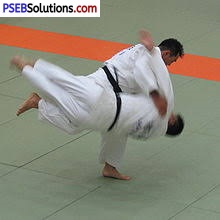
Judo Game Important Points
- The Surface or the Platform:Mat or tatami
- The Dimension of Total Playfield:14 m x 14 m
- The Dimension of Contest and Combat Area:10 m x 10 m
- Duration of Contest (Bout):4 minutes (Men & Women)
- Number of Mats (Tatami): proposed 5 min (for men) 2020 Olympics
- The name of Judo Playfield:50 Mats
- Size of each Mat,Tatami:Shiajo
- Number of Officials:1 x 2m (3′ x 6″)
- Number of Weight Categories:1 Referee 2 Judges 1 Scorer (computerized scoring) 2 Time Keeper.
- Training School of Judo:Dojo
- Distance between the Competitors:(12 feet) 4 mt (from each other)
- Rest Period between the contest:10 minutes
- Width of Obi (belt):4 – 5 cm
![]()
Judo Game Rules And Requlations
1. Weight Classification:
The competition in Judo is conducted on the basis of weight categories for the fair contest. The weight classification for men and women have been listed below:
| Men | Women |
| 1. Below 60 kg | 1. Below 48 kg. |
| 2. Above 60 and below 66 kg | 2. Above 48 and below 52 kg |
| 3. Above 66 and below 73 kg | 3. Above 52 and below 57 kg |
| 4. Above 73 kg and below 81 kg | 4. Above 57 kg and below 63 kg |
| 5. Above 81 kg and below’ 90 kg | 5. Above 63 kg and below- 70 kg |
| 6. Above 90 kg and below 100 kg | 6. Above 70 kg and below7 78 kg |
| 7. Above 100 kg | 7. Above 78 kg |
2. Score:
If one judoka is awarded ‘Ippon’ then he shall be declared the winner. If no ippon is awarded than the player with the highest score with Yuko, Wazari at the end of bout shall be declared the winner. If the score is tied at the end of contest, the match shall be decided by the period of Golden Score. The points are as under
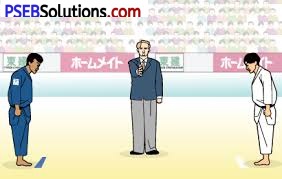
- Ippon: The highest point (to win the contest)
- Wazari: Very close to Ippon
- Yuko: Very close to Wazari.
3. Penalty:
The penalities are awarded for the infringement of rules by the judoka. In case of minor infringement or slight foul (Shido) penalty shall be given and for the major or serious infringement (hanso ku make) penalty shall be given, which means disqualification from the contest.
4. Duration of Contest:
The Judo contest or bout is conducted for the duation of 4 minutes for senior men and women. The proposed duration of bout for Judo at 2020 Olympic Games is 5 minutes for senior men.
5. General Rules of Play:
- The bout shall start with the salutation ‘Rei’ by the both contestant standing opposite to each other at a distance of 12 feet (4 mt.) on the contest area in order to express mutual respect.
- The referee shall start the bout with the command ‘Hajime’ i.e. start the contest.
- In order to stop the contest bout temporality referee shall announce “Matte’ i.e. ‘stop’.
- If one contestant be penalised with Hanso ku-make (serious infringement), the other shall be declared winner immediately.
- If a contestant score ‘Ippon’ (the highest one point) he shall be declared winner, immediately.
- It is not permitted to grip opponent’s sleeves from the inner side of the uniform, e.g. pistol grip, pocket grip etc.
- Holding hand or interlocking of opponent’s fingers in order to prevent attack is not permitted more than 5 seconds.
- It is not permitted to attack joints or Kansetsu – waza (other than elbow joint), punching, kicking, touching opponent’s face, head dives and other strikes with an intension to injure other opponent.
- It is not allowed to move outside or standing outside the contest area.
- The contestant shall not be permitted to wear any hard or metallic object, The penalty for violating this rule is hanso ku make, i.e disqualification.
- To disregard and disobey the referee’s command shall lead to disqualification.
![]()
Playing Arena And Equipment:
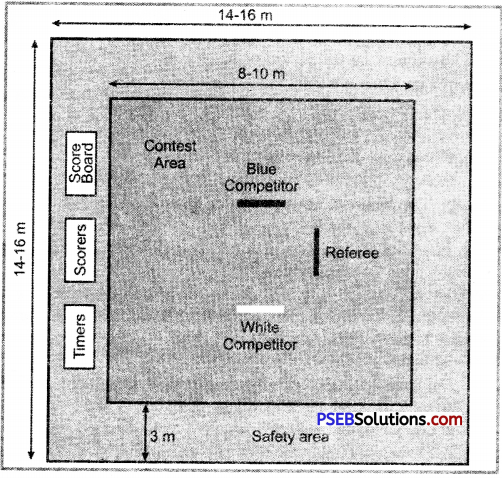
1. Dimension of Shiajo (Judo Play Field):
The platform or competition area is covered by ‘tatamis’ (mats) made up of pressed foam. The dimension of each mat (tatami) shall be 1 m x 2 m. The competition area is 14 m x 14 m i.e. divided into two zone contest area 10 m x 10 m and safety area of 4 m wide around the contest area.
2. Costume (Judogi):
The contestant shall wear judogi (costume) strongly made in cotton or similar material. It should be without rent or tear. The material should not be so hard or thick as to prevent the opponent from taking a grip. The colour of judogi for the first contestant shall be blue and white or off white for the second contestant. The cotton (obi) belt of 4-5 cm width shall be tied around the waist with a square knot.
3. Flags & Chairs:
Two strong but light weight chairs shall be placed in opposite side of the competition area for the judges. Judges flag (one blue and one white) in a holster attached to chair must be kept for the contest.
![]()
Funciamentai Skills
Judo is an intense physical sport combining with offensive techniques of throw, falls, grappling moves such as chocking and locking of joint (elbow joint) and pushing an opponent to the ground. The basic skills for the practice have been explained below :
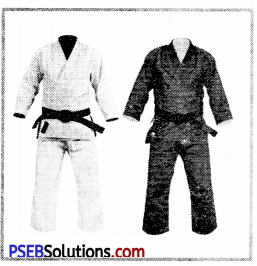
1. Ukemi Waza (Break fall Technique):
These are the basic movement pattern in response to throwing actions. The basic techniques under break fail are :
- Ushiro Ukemi (Rear Fall)
- Yoko Ukemi (Side Fall)
- Mai Ukemi (Front)
- Jenpo Kaiten (Rolling Technique).
2. Kumi-Kata (form of gripping):
This is the most important skill or strategy to learn. It can be learnt with the practice of Kumite-arasoi (grip-fighting). It actually helps to learn to arrive at favourite grip rather than just how to grip the opponent.
3. Waza (Judo techniques):
All Judo techniques can be divided into following groups:
- Nagewaza : Throwing techniques
- Katame – waza : Grappling techniques
- Aterni – waza : Striking techniques.
These techniques are further divided into groups as given in the table below :
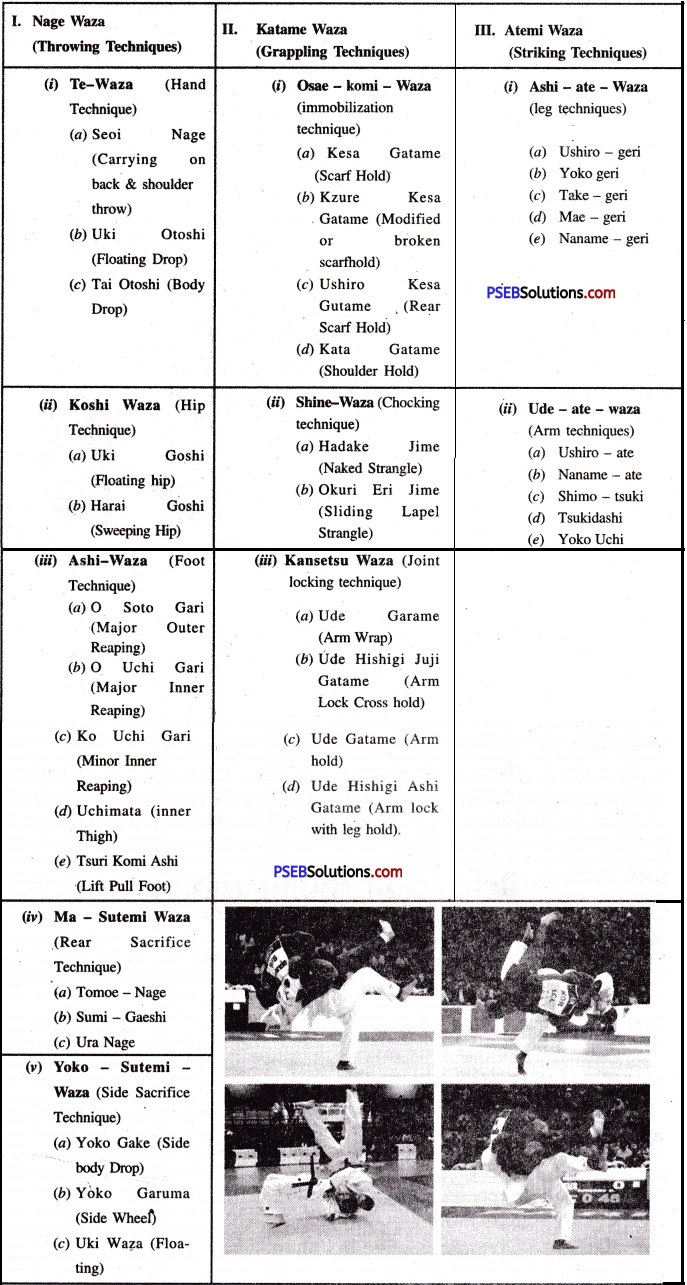
Judo Game Important Terminologies
Since, the game originated in Japan, the terminology used in the game is Japanese. The important terms have been explained below :
- Dojo: The training school of Judo is called ‘dojo’.
- Judogi: The clothes or costume worn by Judo players is called judogi.
- Shiajo: The square platform of mats is known as Shiajo.
- Judoka: The player practicing Judo skills is called a judoka,
- Hajime: The term used by the referee to start the contest.
- Matte: The referee shall announce to stop or pause the contest temporarily.
- Hanso ku make: The referee calls a ‘Hanso Ku make’ to disqualify the contestant for the serious infringement.
- Shido: This penalty is given for the slight infringement.
- Ippon: The highest point to declare the winner.
- Obi: This mean a cotton belt tied around the jacket having a width of 4-5 cm with square knot.
- Sensei: A person who teaches and instruct judo is called sensei.
- Osaekomi: (Mat holding begins) opponent is held under control on his back or immobilize for 25 seconds to win the contest.
- ‘Rei’ (Standing bow): It is an expression of mutual respect to opponent before the contest.
![]()
Judo Game Important Tournaments
International Level
- Olympic Games
- Asian Judo Championship
- World Cup
- Common Wealth Games
- World Junior Judo Championship
- World Senior Judo Championship
National Level
- Senior National Judo Championship
- Junior National Judo Championship
- National Games
- National School Games
- Federation Cup.
Arjuna Award Winners
- Sandeep Byala
- Cawas Billimoria
- Poonam Chopra
- Narinder Singh
![]()
Judo Game Important Questions
Question 1.
What is the literal meaning of Judo?
Answer:
The literal meaning of Judo lies in two words ‘Ju’ (Gentle) and ‘do’ (the way) i.e. the gentle way.
Question 2.
Who was the father of Judo?
Answer:
Dr. Jigaro Kano.
Question 3.
When did the game included in Olympics?
Answer:
The game was included in Tokyo Olympic Games in 1964.
Question 4.
When did International Judo Federation was formed?
Answer:
In the year 1951.
![]()
Question 5.
What is the dimension of total playfield?
Answer:
14 m x 14 m.
Question 6.
What is the dimension of contest area?
Answer:
10 m x 10 m.
Question 7.
How many officials are required for Judo contest?
Answer:
1 Referee, 2 Judges, 1 Scorer, 2 Time Keepers.
Question 8.
What is the width of Obi (belt)?
Answer:
4-5 cm.
Question 9.
How many weight categories are there for men and women?
Answer:
7 weight categories.
![]()
Question 10.
What is the highest point in Judo?
Answer:
Ippon.
Question 11.
What is the duration of Judo contest for men?
Answer:
4 minutes.
Question 12.
What is the term ‘ReF in Judo means?
Answer:
It is an expression of mutual respect to an opponent before the contest.
Question 13.
What term does the referee use to start the contest?
Answer:
Hajime.
Punjab State Board PSEB 12th Class Physical Education Book Solutions 12th Class Physical Education Practical Judo Important Notes, Questions and Answers.